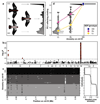Epistatic mutations under divergent selection govern phenotypic variation in the crow hybrid zone
- PMID: 30911146
- PMCID: PMC6445362
- DOI: 10.1038/s41559-019-0847-9
Epistatic mutations under divergent selection govern phenotypic variation in the crow hybrid zone
Abstract
The evolution of genetic barriers opposing interspecific gene flow is key to the origin of new species. Drawing from information on over 400 admixed genomes sourced from replicate transects across the European hybrid zone between all-black carrion crows and grey-coated hooded crows, we decipher the interplay between phenotypic divergence and selection at the molecular level. Over 68% of plumage variation was explained by epistasis between the gene NDP and a ~2.8-megabase region on chromosome 18 with suppressed recombination. Both pigmentation loci showed evidence for divergent selection resisting introgression. This study reveals how few, large-effect loci can govern prezygotic isolation and shield phenotypic divergence from gene flow.
Conflict of interest statement
The authors declare no competing interests.
Figures


References
-
- Mayr E. Systematics and the origin of species. Columbia University Press; 1942.
-
- Randler C. Assortative mating of carrion Corvus corone and hooded crows C. cornix in the hybrid zone in eastern Germany. Ardea. 2007;95:143–149. doi: 10.5253/078.095.0116. - DOI
Publication types
MeSH terms
LinkOut - more resources
Full Text Sources

